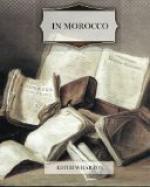“All the children of these couples were in due time destined for the Black Army, or for domestic service in the palaces. Every year the Sultan went to the camp at Mechra Erremel and brought back the children. The Black Army numbered one hundred and fifty thousand men, of whom part were at Erremel, part at Meknez, and the rest in the seventy-six forts which the Sultan built for them throughout his domain. May the Lord be merciful to his memory!”
Such was the army by means of which Ismael enforced the corvee on his undisciplined tribes. Many thousands of lives went to the building of imperial Meknez; but his subjects would scarcely have sufficed if he had not been able to add to them twenty-five thousand Christian captives.
M. Augustin Bernard, in his admirable book on Morocco, says that the seventeenth century was “the golden age of piracy” in Morocco; and the great Ismael was no doubt one of its chief promoters. One understands his unwillingness to come to an agreement with his great friend and competitor, Louis XIV, on the difficult subject of the ransom of Christian captives when one reads in the admiring Ezziani that it took fifty-five thousand prisoners and captives to execute his architectural conceptions.
“These prisoners, by day, were occupied on various tasks; at night they were locked into subterranean dungeons. Any prisoner who died at his task was built into the wall he was building.” (This statement is confirmed by John Windus, the English traveller who visited the court of Moulay-Ismael in the Sultan’s old age.) Many Europeans must have succumbed quickly to the heat and the lash, for the wall-builders were obliged to make each stroke in time with their neighbors, and were bastinadoed mercilessly if they broke the rhythm; and there is little doubt that the expert artisans of France, Italy and Spain were even dearer to the old architectural madman than the friendship of the palace-building despot across the sea.
Ezziani’s chronicle dates from the first part of the nineteenth century, and is an Arab’s colorless panegyric of a great Arab ruler; but John Windus, the Englishman who accompanied Commodore Stewart’s embassy to Meknez in 1721, saw the imperial palaces and their builder with his own eyes, and described them with the vivacity of a foreigner struck by every contrast.
Moulay-Ismael was then about eighty-seven years old, “a middle-sized man, who has the remains of a good face, with nothing of a negro’s features, though his mother was a black. He has a high nose, which is pretty long from the eyebrows downward, and thin. He has lost all his teeth, and breathes short, as if his lungs were bad, coughs and spits pretty often, which never falls to the ground, men being always ready with handkerchiefs to receive it. His beard is thin and very white, his eyes seem to have been sparkling, but their vigor decayed through age, and his cheeks very much sunk in.”




